Abstract
Background:
Problematic Internet Use (PIU) is a growing problem in Egyptian adolescents. This study was designed to assess the prevalence of PIU among high school students in El-Minia Governorate and to determine the personal, clinical, and social characteristics of them.
Methods:
A cross-sectional study was applied among a random sample of high school students in El-Minia Governorate. PIU was assessed by the 20-item Young Internet Addiction Test (YIAT). Information was also collected on demographics, dietary, and health-related factors. Statistical analysis used: Statistical Package for Social Sciences (SPSS-16) software was used. Chi-square test (X2), Fisher's Exact Test, and one-way analysis of variance (ANOVA) were used whenever, applicable. Multinomial logistic regression analyses were also applied in order to calculate the odds ratios (OR).
Results:
Of the 605 students, 16 (2.6%) were Problematic Internet Users (PIUs), 110 (18.2%) were Potential (PIUs). Adolescents with PIU were associated with male gender, poor friends’ relations, bad family relations, irregular bedtime, and bad personal hygiene. PIUs were more likely to suffer from physical symptoms; weight gain, joint stiffness, lack of physical energy, and emotional symptoms.
Conclusions:
The prevalence of PIU reported in this study is low, however, the Potential PIUs was high and preventative measures are recommended.
Keywords: Egypt, high school students, problematic internet use
INTRODUCTION
The internet has become an important tool for social interaction, information, and entertainment.[1] However, as the internet has moved into homes, schools, internet cafes, and businesses, there has been a rapidly growing public awareness of the potential adverse effects arising from excessive, mal-adaptive or addictive internet usage which is a condition also known by terms such as Problematic Internet Use (PIU), internet addiction, internet dependence, and pathological internet use.[2]
Particularly among adolescents, the internet is observed to be increasingly adopted as a readily accessible means for information retrieval, entertainment, and socialization.[3] As adolescents allocate ever increasing time periods for internet use, the risk for developing mal-adaptive internet use (MIU), including potential PIU and PIU, is inherent.[4] Beard and Wolf defined PIU as use of the internet that creates psychological, social, school, and/or work difficulties in a person's life.[5]
The proposed criteria for PIU initially included: (1) An uncontrollable use of the internet, (2) internet use which is markedly distressing, time consuming or resulting in social, occupational, or financial difficulties, and (3) internet use not solely present during hypomanic or manic clinical episodes.[6] Hence, PIU is conceptualized as an individual's inability to control his/her use of the internet, thus causing marked distress and/or functional impairment.[7] Potential PIU is defined as internet use which fulfils some of the PIU criteria.[8]
Worldwide, the prevalence of PIU among adolescents and young adults has been observed to range between 0.9%[9] and 38%.[10] International estimates of adolescent PIU vary widely. In Europe, the prevalence has been reported to be between 1% and 9%[11], in the Middle East the prevalence is between 1% and 12%,[12] and in Asia the prevalence has been reported to be between 2% and 18%.[13] As one of the common mental health problems among Chinese adolescents, PIU is currently becoming more and more serious.[14]
The negative impacts of PIU have progressively emerged. Recently, numerous studies had shown indulging in the use of the internet is associated with a variety of problems. High-risk Internet users have inappropriate dietary behavior and poor diet quality, which could result in stunted growth and development.[15] PIU was also associated with other potential addictive personal habits of smoking, drinking alcohol or coffee, and taking drugs.[16] Internet use in adolescents was associated with more severe psychiatric symptoms,[17] and interpersonal problems.[18]
Objectives
The primary objective of the present study is to assess the prevalence of PIU among high school students in El-Minia Governorate. The secondary objective is to investigate the potential risk factors for PIU among high school students in El-Minia Governorate.
METHODS
Settings and design
This study was conducted during January-March 2012, at El-Minia governorate. This governorate is one of the Upper Egypt governorates and is 240 km to the south of Cairo. It is a cross-sectional descriptive study to assess the prevalence and determinants of PIU among adolescent students at different high schools at El-Minia governorate.
Sample size and sampling design
In El-Minia governorate, there are 85 different high schools. From these schools, four schools were randomly selected to cover the whole sample size (two boys schools and two girls schools). The sample size was 574 calculated using EPI Info 2000 entering average estimates of PIU 3% “based on a pilot study that was carried out on 50 high school students who were not included in the main study” and the total number of high school students as 12,283 and the confidence level at 99.99%. To regard against non responsiveness, 620 students were contacted and of these, 605 agreed to participate in the study.
Study instrument
Data were collected using a self-administered questionnaire. Our questionnaire was filled in within a 20-30 min session in the classroom in the presence of the teachers to minimize any potential information bias.
Data collection
The questionnaire started with demographic data about each participant, followed by family, dietary and health-related data. The Young's Internet Addiction Test (YIAT) was applied in order to assess PIU. The YIAT consists of 20 items for the evaluation of the degree of preoccupation, compulsive use, behavioral problems, emotional changes, and diminished functionality associated with internet use. Each item is scored from 1 to 5, with 1 representing “not at all” and 5 representing “always”. Hence, possible total scores range from 20 to 100. The following cut-off points were applied to the total YIAT score (1) Normal Internet use: Scores 20-49; (2) Potential PIU: Scores 50-79; (3) PIUs: Scores 80-100.[19] MIU was defined among those participants with either potential PIU or PIU.[20]
Ethical and administrative considerations
Official permissions were obtained from relevant authorities to proceed with the study. Prior to embarking on the study, ethical approval was obtained from the Scientific Research Ethics Committee of El-Minia University, Faculty of Medicine. Official permission was obtained from the Administration of Secondary Education and from the Manager of each school before data collection. In addition, informed consent was secured from each participant. The purpose of the study was explained to all the participants and was ensured strict confidentiality and anonymity before proceeding in the interview.
Statistical application
All data were analyzed by using the Statistical Package for Social Sciences (SPSS-16) software. Descriptive analyses were performed on all variables and the prevalence of PIU. Chi-square test(X2), Fisher's Exact Test and One-way analysis of variance (ANOVA) were used whenever, applicable. Multinomial logistic regression analyses were also applied to calculate the odds ratios (OR) and 95% CI of the determinants of Internet addiction among students. P < 0.05 was used as the definition of statistical significance.
RESULTS
Among the study population (n = 605), there were 396 (65.5%) male students and 209 (34.5%) female students. The mean age ± standard deviation (SD) of adolescents with PIU did not significantly differ from that of their normal Internet user counterparts (16.9 ± 0.3 years vs. 16.49 ± 0.8 years, F = 2.4, P = 0.09). Approximately 2.6% (16) were identified as PIUs and males comprised 87.5% among them, while 110 (18.2%) were identified as potential PIUs and most of them were males (70%). Mostly of PIUs their fathers have professional work (93.7%) and their mothers were housewives (68.7%). Beginning age of Internet use was earlier among PIU students than normal Internet users (12.2 ± 1.9 vs. 13.25 ± 1.9, F = 3.5, P = 0.03). With respect to the locations of Internet access, most of the participants owned and frequently used computers in their homes and adolescents with PIU were significantly more likely to access the Internet via their own home portal as compared to normal Internet users [Table 1].
Table 1.
Socio-demographic characteristics based on level of internet addiction among the students
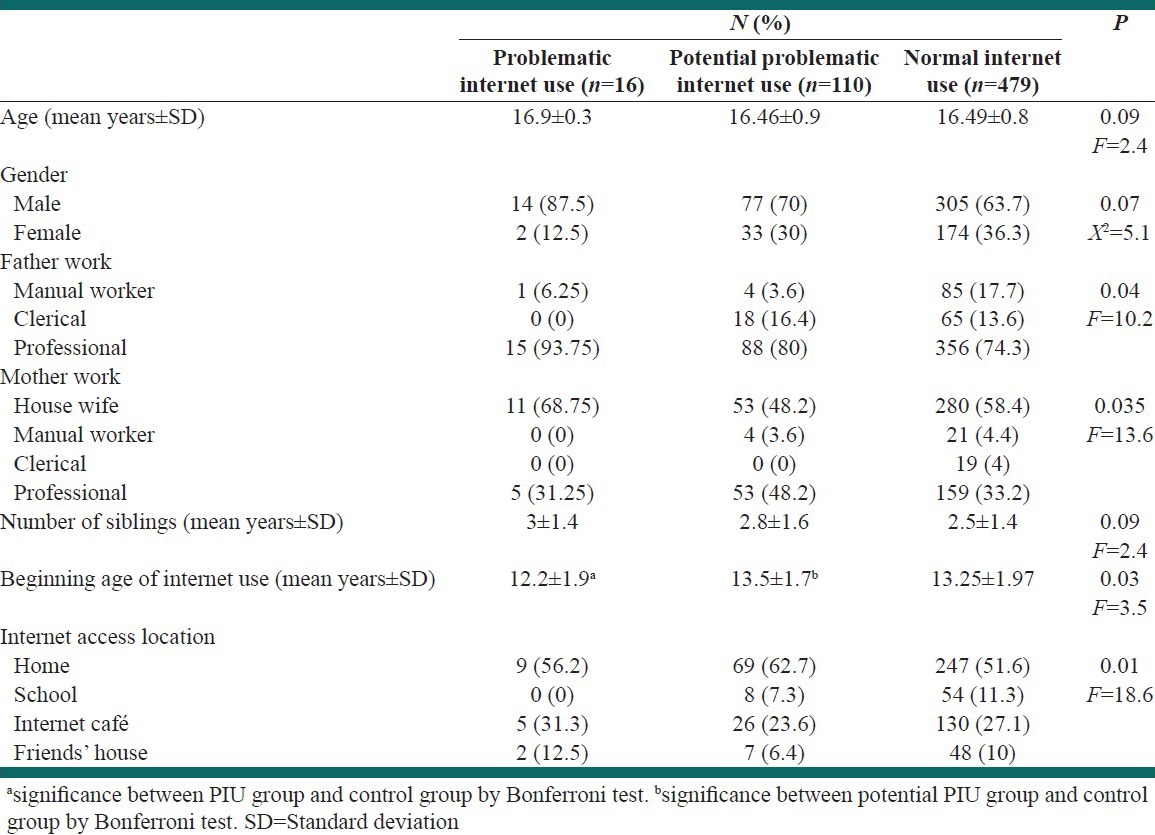
As shown in Table 2, PIU was significantly associated with a series of variables: Low social friends (62.8% vs. 19.8%, X2 = 40.6, P = 0.001), bad family relations (43.8% vs. 20.3%, X2 = 5.2, P = 0.07), irregular bedtime (62.5% vs. 2.5%, Fisher's Exact Test = 189, P = 0.0001), and bad personal hygiene (50% vs. 16.7%, X2 = 26.7, P = 0.0001). Moreover, the proportion of adolescents with PIU reporting excellent academic performance was lower than that among normal Internet users (6.5% vs. 20.9%, X2 = 16.2, P = 0.03).
Table 2.
Lifestyle patterns based on the level of internet addiction among the students
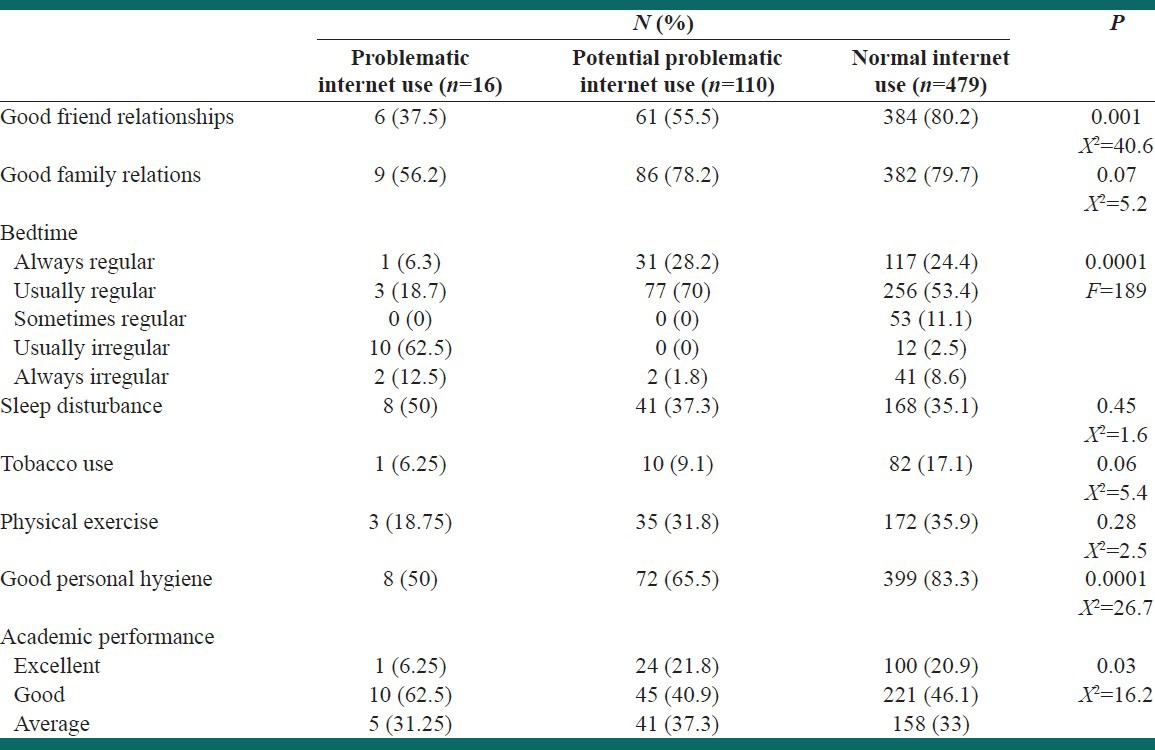
Most of PIUs answered that their dietary habits had been changed to have small meal sizes, a poor appetite, and faster eating speeds than normal Internet users (X2 = 43.4, P = 0.001, X2 = 32.6, P = 0.001, and X2 = 13.01, P = 0.01, respectively). PIUs had a higher percentage of skipping breakfast (62.5% vs. 33.4%, X2 =6.6, P = 0.03) as shown in Table 3.
Table 3.
Dietary habits based on the level of internet addiction among the students
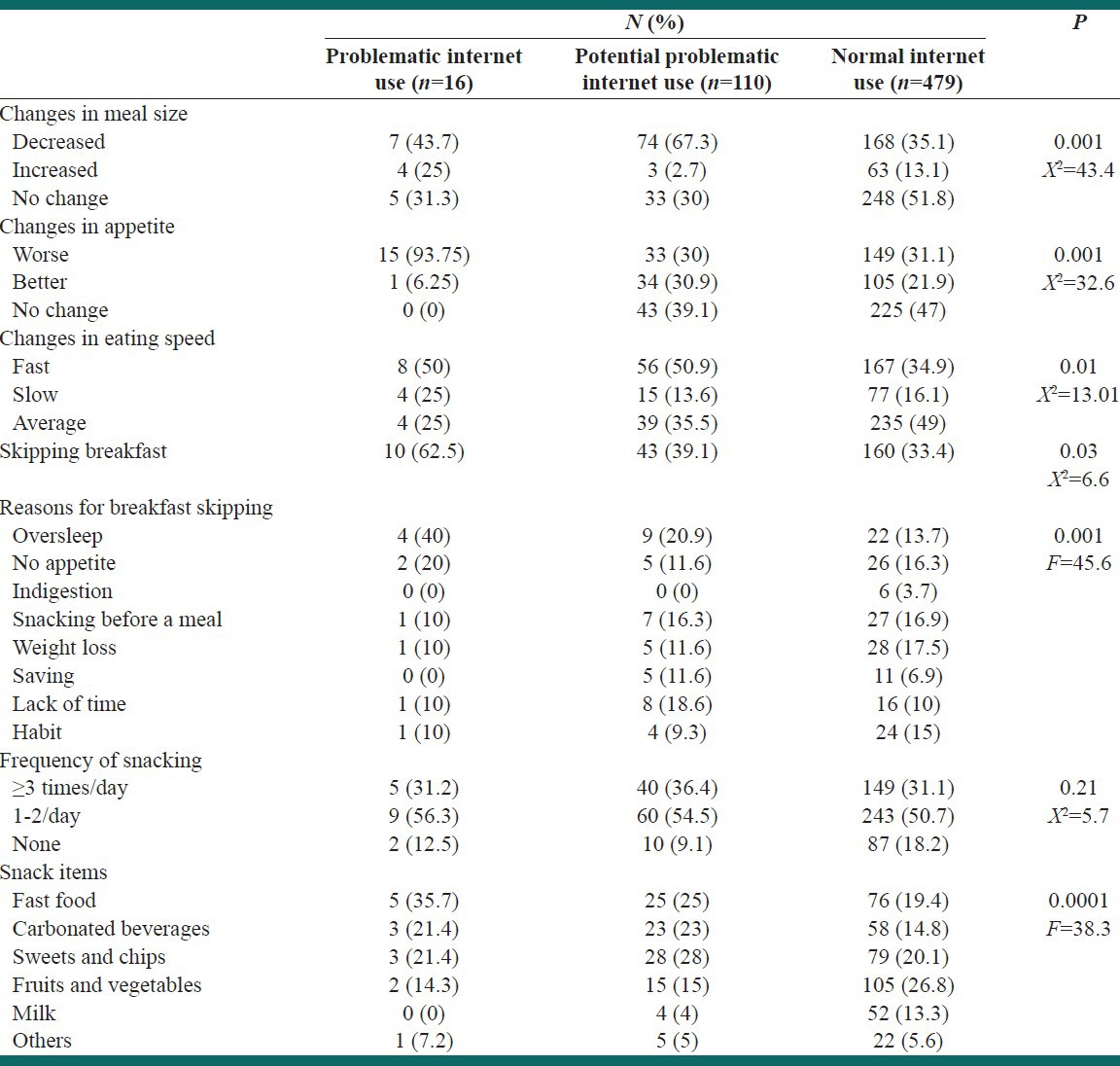
Table 4 showed the percentage of some physical and emotional symptoms among adolescents with PIU, potential PIU, and normal Internet use. Compared with normal Internet use, adolescents with PIU were more likely to suffer from physical symptoms; weight gain (31.2% vs. 15.9%, X2 = 8.5, P = 0.01), joint stiffness (12.5% vs. 2.9%, X2 = 6.3, P = 0.04), lack of physical energy (43.7% vs. 24.6%, X2 = 14.9, P = 0.001), back pain (62.5% vs. 39.5%, X2 = 5.7, P = 0.05), eye strain (62.5% vs. 34.03%, X2 = 18.6, P = 0.0001), and emotional symptoms; feeling sad (25% vs. 5.6%, X2 = 22.1, P = 0.001), feeling excited (68.7% vs. 12.1%, X2 = 85.1, P = 0.001), euphoric (18.7% vs. 5.4%, X2 = 17.7, P = 0.001), and anxious (6.25% vs. 8.03%, X2 = 9.17, P = 0.01).
Table 4.
Physical and emotional health problems caused by internet use among students
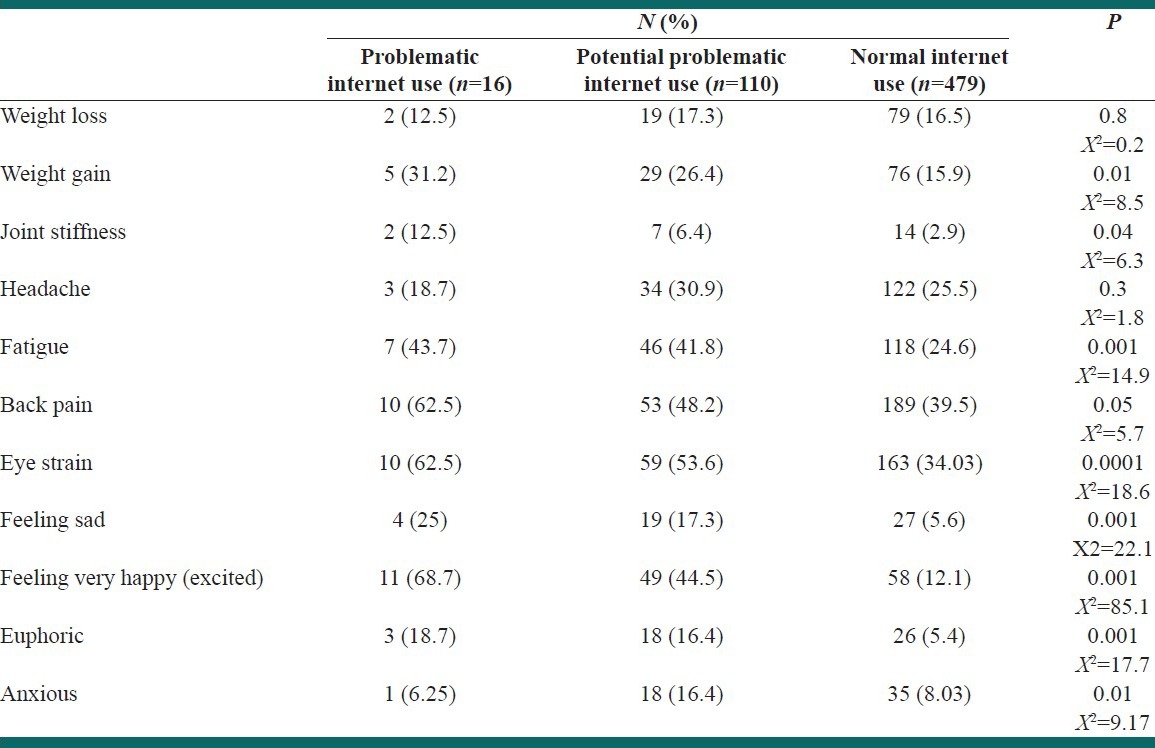
Determinants of potential PIU and PIU: The multinomial logistic regression analysis [Table 5] indicated that father's professional work, poor family relation, male gender, and limited social friends were independently associated with potential PIU and PIU.
Table 5.
Multinomial logistic regression analyses for identifying the determinants of internet addiction among students
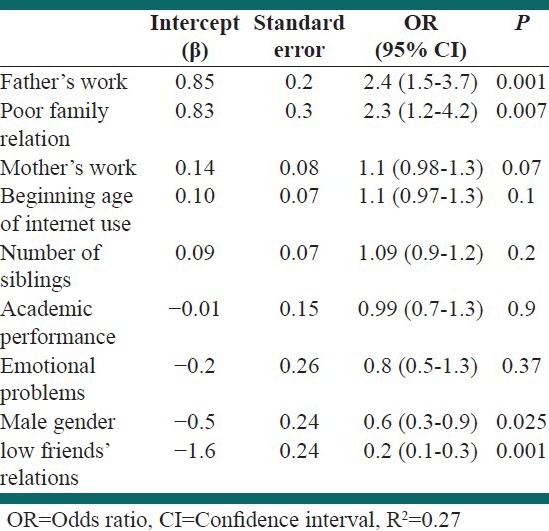
DISCUSSION
The Internet is extremely an important social and communications tool, and is changing our daily lives at home and at work. There is no doubt that some Internet users develop problematic behavior.[21] There is no an epidemiological study on PIU neither in general nor in adolescence in Egypt. In light of these findings, this study was conducted in order to assess the prevalence of PIU among high school students and to determine the personal, clinical, family, and social characteristics of PIU among adolescents.
The study participants were 605 high school students. Most of the participants owned and frequently used computers in their homes. Three types of Internet users were identified in this study: Normal, potential PIUs, and PIUs. The prevalence of PIU among adolescents was 2.6%, which is closely related to that reported by some other studies of Internet use among students worldwide; such as PIU was 1% in Greece[1], 4% in South Korea,[22] 3.1% in Finland,[23] 4.2% in Lebanon,[24] and 4.6% in Australia.[25] Its lower percentage may be attributed to the limited access of computer/Internet access among urban Egyptian youth. However, marked international variances regarding the prevalence rates of PIU may also be attributed to a measurement bias incurred by a lack of international consistency regarding both the definition and assessment of PIU[26] and to different samples and social contexts. Furthermore, among the study population examined about 18.2% of adolescents were identified with potential PIU which is slightly lower than what found in another study; that approximately one-fifth (19.4%) of adolescents were identified with potential PIU.[4]
Empirical studies have suggested gender as a predictive factor of PIU. Previous study has found that male Internet users were more subject to PIU.[1] In contrast, another study contended that females were more prone to PIU than males.[27] However, one study found no gender differences in relation to internet addiction (IA).[28] This study supports the general literature that males tend to be more subject to PIU and the explanation for this may be that males are more likely to play online games, engage in cybersex, and gamble online.
According to Korean scientists, the causes of PIU do not have only habitual bases, but also demographic and socioeconomic.[11] The present study partly confirmed this by the finding that parents’ work and students who have higher number of siblings were more in danger of PIU.
This study shows that PIU adolescents at were much more likely to have interpersonal problems, as PIU was significantly higher among adolescents had poor social friends and family relations. Researchers state that widespread use of the Internet among the adolescents makes them feel alone, causes problematic behaviors, and leads to poor family and friends relationships.[29] High parent-adolescent conflict predicted PIU in adolescents; as adolescents with a higher conflict level with their parents refused to obey the supervision of their parents, including the rules set for Internet use.[30]
High-risk Internet users reported more irregular sleep patterns and more episodes of sleep disturbance than no risk Internet users. This is consistent with a previous study of Korean adolescents that showed that PIU was associated with insomnia, apnea, and nightmare.[31] Late night use of the Internet can cause sleep deprivation and fatigue, which can adversely affect academic performance and can result in reversed sleep pattern and poor academic performance.[32]
In this study, PIU is more among adolescents who had skipping breakfast habit. This finding seems reasonable since PIU stay up late at night and may get up too late for breakfast.[33] The high frequency of snaking could be related to skipping meals, more frequent snacking was observed in PIUs than normal internet users. Moreover, the favorite snacks of our participants were fast food, which are nutritionally poor foods with high calories provided by fats and simple sugars but with few other nutrients such as vitamins and minerals. Thus PIUs have improper dietary behaviors that could impact their growth and development. This is matched with a study found that PIU had the lowest meal regularity, reflected by a higher rate of snaking than in normal Internet users.[15]
Children and adolescents carry a much higher risk for negative effects of PIU than adults due to incomplete developmental processes. Our study found adolescents with PIU were more likely to suffer from physical symptoms, such as lack of physical energy (students may look overly tired or sleep in class because of all-night Internet sessions), change of sleep pattern,[34] back strain, and eye strain from the long periods of sedentary computer use. This risk was reported to increase by excessive Internet and computer use.[35] PIUs may be depressed, withdrawn, or anxious as a result of both the physical and psychological toll of the PIU.[36]
Frequently and increasingly PIUs cut themselves off from their family, friends, and social activities and choose to spend most of their time alone. This study shows that father's professional work, and poor family relation were the most contributing risk factor of PIU, these results may suggest a relationship between a poor social support system and PIU.[37]
Some potential limitations have also been identified in this study. First, this study was a cross-sectional study, therefore, we could not confirm causal associations between PIU and its consequences. Second, the questionnaire was self-reported and is subject to recall or report bias. Third, since the survey was administered during class time, it is possible that some students, especially those had PIU, were absent from class when the questionnaire was administered. Therefore, the survey may have under-represented PIU by failing to record the responses of those who are so consumed by the Internet that they rarely leave their rooms, thus leading to an underestimation of the prevalence of PIU. Future studies should attempt to determine implementation of preventive measures, and the development of treatment approaches for PIU.
CONCLUSION
PIU is not rare among Egyptian high school students. Adolescents with PIU had an augmented likelihood to report poor social and familial relationships, and enhanced risk for some physical and emotional health problems.
Recommendations
School counselors and teachers also need to be aware of the prevalence and the problematic behaviors associated with excessive internet use for early prevention. It is also necessary to make the youth and their parents aware of the dangers of PIU and pay attention to consequences connected with it.
ACKNOWLEDGMENT
The authors would like to offer their sincere thanks to all students who participated in the study, and who gave of their time to answer our questions.
Footnotes
Source of Support: Nil
Conflict of Interest: None declared
REFERENCES
- 1.Tsitsika A, Critselis E, Kormas G, Filippopoulou A, Tounissidou D, Freskou A, et al. Internet use and misuse: A multivariate regression analysis of the predictive factors of Internet use among Greek adolescents. Eur J Pediatr. 2009;168:655–65. doi: 10.1007/s00431-008-0811-1. [DOI] [PubMed] [Google Scholar]
- 2.Cooney GM, Morris J. Time to start taking an internet history? Br J Psychiatry. 2009;194:85. doi: 10.1192/bjp.194.2.185. [DOI] [PubMed] [Google Scholar]
- 3.Suss D. Impacts of computer- and media usage on the personality development of children and young people. Ther Umsch. 2009;64:103–8. doi: 10.1024/0040-5930.64.2.103. [DOI] [PubMed] [Google Scholar]
- 4.Kormas G, Critselis E, Janikian M, Kafetzis D, Tsitsika A. Risk factors and psychosocial characteristics of potential problematic and problematic internet use among adolescents: A cross-sectional study. BMC Public Health. 2011;11:595. doi: 10.1186/1471-2458-11-595. [DOI] [PMC free article] [PubMed] [Google Scholar]
- 5.Beard KW, Wolf EM. Modification in the proposed diagnostic criteria for Internet addiction. Cyberpsychol Behav. 2001;4:377–83. doi: 10.1089/109493101300210286. [DOI] [PubMed] [Google Scholar]
- 6.Shapira NA, Goldsmith TD, Keck PE, Jr, Khosla UM, McElroy SL. Psychiatric features of individuals with problematic internet use. J Affect Disord. 2000;57:267–72. doi: 10.1016/s0165-0327(99)00107-x. [DOI] [PubMed] [Google Scholar]
- 7.Taintor Z. Telemedicine, telepsychiatry, and online therapy. In: Sadock BJ, Sadock VA, editors. Kaplan and Sadock's Comprehensive Textbook of Psychiatry. 8th ed. Philadelphia: Lippincott Williams and Wilkins Publishers; pp. 955–63. [Google Scholar]
- 8.Young KS. Internet addiction: Symptoms, evaluation, and treatment. In: Vande-Creek L, Jackson T, editors. Innovations in Clinical Practice: A Source Book. Vol. 17. Sarasota: Professional Resource Press; 1999. pp. 19–31. [Google Scholar]
- 9.Yoo HJ, Cho SC, Ha J, Yune SK, Kim SJ, Hwang J, et al. Attention deficit hyperactivity symptoms and internet addiction. Psychiatry Clin Neurosci. 2004;58:487–94. doi: 10.1111/j.1440-1819.2004.01290.x. [DOI] [PubMed] [Google Scholar]
- 10.Leung L. Net-generation attributes and seductive properties of the internet as predictors of online activities and internet addiction. Cyberpsychol Behav. 2004;7:333–48. doi: 10.1089/1094931041291303. [DOI] [PubMed] [Google Scholar]
- 11.Zboralski K, Orzechowska A, Talarowska M, Darmosz A, Janiak A, Janiak M, et al. The prevalence of computer and internet addiction among pupils. Postepy Hig Med Dosw (Online) 2009;63:8–12. [PubMed] [Google Scholar]
- 12.Canbaz S, Tevfik SA, Peksen Y, Canbaz M. Prevalence of the pathological internet use in a sample of Turkish school adolescents. Iranian J Publ Health. 2009;38:64–71. [Google Scholar]
- 13.Park SK, Kim JY, Cho CB. Prevalence of Internet addiction and correlations with family factors among South Korean adolescents. Adolescence. 2008;43:895–909. [PubMed] [Google Scholar]
- 14.Cao F, Su L, Liu T, Gao X. The relationship between impulsivity and Internet addiction in a sample of Chinese adolescents. Eur Psychiatry. 2007;22:466–71. doi: 10.1016/j.eurpsy.2007.05.004. [DOI] [PubMed] [Google Scholar]
- 15.Kim Y, Park JY, Kim SB, Jung IK, Lim YS, Kim JH. The effects of internet addiction on the lifestyle and dietary behavior of Korean adolescents. Nutr Res Pract. 2010;4:51–7. doi: 10.4162/nrp.2010.4.1.51. [DOI] [PMC free article] [PubMed] [Google Scholar]
- 16.Frangos CC, Frangos CC, Sotiropoulos I. Problematic internet use among Greek university students: An ordinal logistic regression with risk factors of negative psychological beliefs, pornographic sites, and online games. Cyberpsychol Behav Soc Netw. 2011;14:51–8. doi: 10.1089/cyber.2009.0306. [DOI] [PubMed] [Google Scholar]
- 17.Kelleci M, Inal S. Psychiatric symptoms in adolescents with internet use: Comparison without internet use. Cyberpsychol Behav Soc Netw. 2010;13:191–4. doi: 10.1089/cyber.2009.0026. [DOI] [PubMed] [Google Scholar]
- 18.Seo M, Kang HS, Yom YH. Internet addiction and interpersonal problems in Korean adolescents. Comput Inform Nurs. 2009;27:226–33. doi: 10.1097/NCN.0b013e3181a91b3f. [DOI] [PubMed] [Google Scholar]
- 19.Khazaal Y, Billieux J, Thorens G, Khan R, Louati Y, Scarlatti E, et al. French validation of the internet addiction test. Cyberpsychol Behav. 2008;11:703–6. doi: 10.1089/cpb.2007.0249. [DOI] [PubMed] [Google Scholar]
- 20.Chang M, Law S. Factor structure for young's internet addiction test: A confirmatory study. Comput Human Behav. 2008;24:2597–619. [Google Scholar]
- 21.Yellowlees P, Marks S. Problematic internet use or internet addiction? Comput Human Behav. 2007;23:1447–53. [Google Scholar]
- 22.Lee MS, Ko YH, Song HS, Kwon KH, Lee HS, Nam M, et al. Characteristics of internet use in relation to game genre in Korean adolescents. Cyberpsychol Behav. 2007;10:278–85. doi: 10.1089/cpb.2006.9958. [DOI] [PubMed] [Google Scholar]
- 23.Kaltiala-Heino R, Lintonen T, Rimpela A. Internet addiction? Potentially problematic use of the Internet in a population of 12-18 year-old adolescents. Addiction Res and Theory. 2004;12:89–96. [Google Scholar]
- 24.Hawi N. Internet addiction among adolescents in Lebanon. Comput Human Behav. 2012;28:1044–53. [Google Scholar]
- 25.Thomas NJ, Martin FH. Video-arcade game, computer game and internet activities of Australian students: Participation habits and prevalence of addiction. Aust J Psychol. 2010;62:59–66. [Google Scholar]
- 26.Byun S, Ruffini C, Mills JE, Douglas AC, Niang M, Stepchenkova S, et al. Internet addiction: Metasynthesis of 1996-2006 quantitative research. Cyberpsychol Behav. 2009;12:203–7. doi: 10.1089/cpb.2008.0102. [DOI] [PubMed] [Google Scholar]
- 27.Young K. Internet addiction: The emergence of a new clinical disorder. Cyberpsychol Behav. 1996;1:237–44. [Google Scholar]
- 28.Lam LT, Peng ZW, Mai JC, Jing J. Factors associated with Internet addiction among adolescents. Cyberpsychol Behav. 2009;12:551–5. doi: 10.1089/cpb.2009.0036. [DOI] [PubMed] [Google Scholar]
- 29.Wang H, Zhou X, Lu C, Wu J, Hong L, Deng X. Problematic internet use in high school students in guangdong province, China. PLoS One. 2011;6:e19660. doi: 10.1371/journal.pone.0019660. [DOI] [PMC free article] [PubMed] [Google Scholar]
- 30.Yen JY, Yen CF, Chen CC, Chen SH, Ko CH. Family factors of internet addiction and substance use experience in Taiwanese adolescents. Cyberpsychol Behav. 2007;10:323–9. doi: 10.1089/cpb.2006.9948. [DOI] [PubMed] [Google Scholar]
- 31.Choi K, Son H, Park M, Han J, Kim K, Lee B, et al. Internet overuse and excessive daytime sleepiness in adolescents. Psychiatry Clin Neuosci. 2009;63:455–62. doi: 10.1111/j.1440-1819.2009.01925.x. [DOI] [PubMed] [Google Scholar]
- 32.Flisher C. Getting plugged in: An overview of internet addiction. J Paediatr Child Health. 2010;46:557–9. doi: 10.1111/j.1440-1754.2010.01879.x. [DOI] [PubMed] [Google Scholar]
- 33.Tsai HF, Cheng SH, Yeh TL, Shih CC, Chen KC, Yang YC, et al. The risk factors of internet addiction: A survey of university freshmen. Psychiatry Res. 2009;167:294–9. doi: 10.1016/j.psychres.2008.01.015. [DOI] [PubMed] [Google Scholar]
- 34.Alavi SS, Ferdosi M, Jannatifard F, Eslami M, Alaghemandan H, Setare M. Behavioral addiction versus substance addiction: Correspondence of psychiatric and psychological views. Int J Prev Med. 2012;3:290–4. [PMC free article] [PubMed] [Google Scholar]
- 35.Whang LS, Lee S, Chang G. Internet over-users’ psychological profiles: A behavior sampling analysis on internet addiction. Cyberpsychol Behav. 2003;6:143–50. doi: 10.1089/109493103321640338. [DOI] [PubMed] [Google Scholar]
- 36.Alavi SS, Alaghemandan H, Maracy MR, Jannatifard F, Eslami M, Ferdosi M. Impact of addiction to internet on a number of psychiatric symptoms in students of isfahan universities, Iran, 2010. Int J Prev Med. 2012;3:122–7. [PMC free article] [PubMed] [Google Scholar]
- 37.Nalwa K, Anand AP. Internet addiction in students: A cause of concern. Cyberpsychol Behav. 2003;6:653–6. doi: 10.1089/109493103322725441. [DOI] [PubMed] [Google Scholar]


